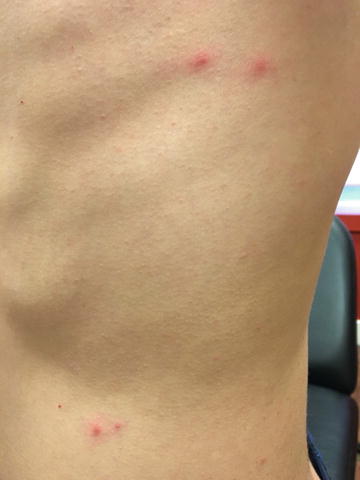, Corinna Eleni Psomadakis2 and Bobby Buka3
(1)
Department of Family Medicine, Mount Sinai School of Medicine Attending Mount Sinai Doctors/Beth Israel Medical Group-Williamsburg, Brooklyn, NY, USA
(2)
School of Medicine Imperial College London, London, UK
(3)
Department of Dermatology, Mount Sinai School of Medicine, New York, NY, USA
Keywords
Bed bugsBiteInsectHemiptera Cimex lectularius PapulePunctumCarbon dioxideUrticariaBreakfast lunch dinnerCorticosteroidAntihistamine
Fig. 40.1
Grouped erythematous, edematous papules with surrounding wheal
Primary Care Visit Report
A 24-year-old male with no prior medical history presented with a rash on his trunk after a weekend away with friends at an upstate New York rental property. The patient slept in pajama bottoms only, without any clothes covering his torso or arms. The patient woke up with discrete papular lesions on his trunk. The lesions were very itchy, and they developed surrounding welts over a few hours after waking. No blood was noted on the sheets. His partner in bed did not have any lesions.
Vitals were normal. On examination, on his left lateral trunk, there were four 3–4 mm erythematous papules with surrounding erythema.
Given that the lesions were very itchy, they presented in pairs, and the patient had slept in a different bed in a rental property, the possibility of bed bugs was considered to be high. The lesions were treated as bed bugs. The patient was advised to take an over-the-counter anti-histamine to help relieve the pruritus , and was prescribed Desonide 0.05 % (Class VI) steroid cream to reduce inflammation and associated pruritus .
The patient was advised to take precautions with his clothing and any belongings he brought to the rental property so as not to introduce bed bugs into his own home. He was advised to wash anything he had with him in hot water and to inspect his suitcase for bed bugs and bug fecal matter.
Discussion from Dermatology Clinic
Differential Dx
Bedbug bites
Scabies
Flea bites
Urticaria
Body lice (pediculosis corporis)
Favored Dx
Bedbug bites can be difficult to differentiate from other insect bites. In this case, finding new bites in the morning on areas of the body that were exposed, coupled with sleeping in a new location that may be particularly vulnerable to bedbugs due to higher numbers of travelling visitors, are factors that support a diagnosis of bedbug bites.
Overview
The common bedbug, Cimex lectularius , is a blood-feeding insect of the order Hemiptera . C. lectularius is flat, wingless, brown, and typically 2–5 mm in size [1]. They are nocturnal feeders and spend the daytime hiding often in the cracks of headboards, crevices of bed frames, and mattress seams. They emerge from their hiding places when they sense the body warmth and expired carbon dioxide of their victims [2]. Bedbugs feed every 3–5 days, but they can go up to 1 year without feeding [1–3].
Bedbug infestations are becoming increasingly prevalent in the USA and worldwide, perhaps owed to increased travel and insecticide resistance [1, 3–5]. They were once associated with disadvantaged socioeconomic status; however, bed bugs can affect individuals of all socioeconomic strata. Infestations can be found in hotels, homes, offices, nursing homes, trains, buses, or ships. Bedbugs may spread through clothing, luggage, used furniture, and mattresses. They are not thought to be vectors for human viruses or disease [1, 2].
Stay updated, free articles. Join our Telegram channel

Full access? Get Clinical Tree








